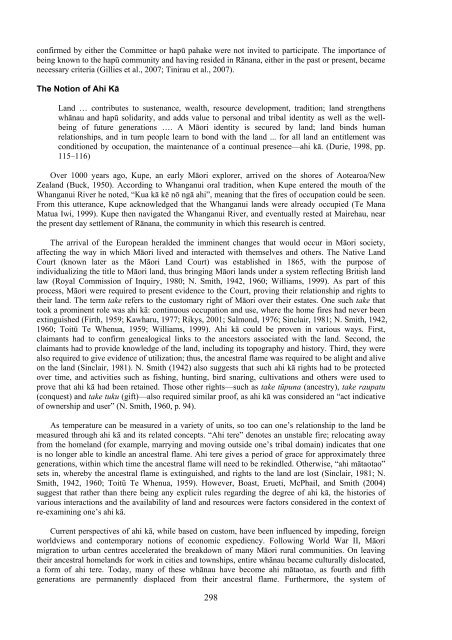traditional knowledge conference 2008 te tatau pounamu
traditional knowledge conference 2008 te tatau pounamu
traditional knowledge conference 2008 te tatau pounamu
You also want an ePaper? Increase the reach of your titles
YUMPU automatically turns print PDFs into web optimized ePapers that Google loves.
confirmed by either the Commit<strong>te</strong>e or hapū pahake were not invi<strong>te</strong>d to participa<strong>te</strong>. The importance ofbeing known to the hapū community and having resided in Rānana, either in the past or present, becamenecessary cri<strong>te</strong>ria (Gillies et al., 2007; Tinirau et al., 2007).The Notion of Ahi KāLand … contribu<strong>te</strong>s to sus<strong>te</strong>nance, wealth, resource development, tradition; land strengthenswhānau and hapū solidarity, and adds value to personal and tribal identity as well as the wellbeingof future generations …. A Māori identity is secured by land; land binds humanrelationships, and in turn people learn to bond with the land ... for all land an entitlement wasconditioned by occupation, the main<strong>te</strong>nance of a continual presence—ahi kā. (Durie, 1998, pp.115–116)Over 1000 years ago, Kupe, an early Māori explorer, arrived on the shores of Ao<strong>te</strong>aroa/NewZealand (Buck, 1950). According to Whanganui oral tradition, when Kupe en<strong>te</strong>red the mouth of theWhanganui River he no<strong>te</strong>d, “Kua kā kē nō ngā ahi”, meaning that the fires of occupation could be seen.From this ut<strong>te</strong>rance, Kupe ac<strong>knowledge</strong>d that the Whanganui lands were already occupied (Te ManaMatua Iwi, 1999). Kupe then naviga<strong>te</strong>d the Whanganui River, and eventually res<strong>te</strong>d at Mairehau, nearthe present day settlement of Rānana, the community in which this research is centred.The arrival of the European heralded the imminent changes that would occur in Māori society,affecting the way in which Māori lived and in<strong>te</strong>rac<strong>te</strong>d with themselves and others. The Native LandCourt (known la<strong>te</strong>r as the Māori Land Court) was established in 1865, with the purpose ofindividualizing the title to Māori land, thus bringing Māori lands under a sys<strong>te</strong>m reflecting British landlaw (Royal Commission of Inquiry, 1980; N. Smith, 1942, 1960; Williams, 1999). As part of thisprocess, Māori were required to present evidence to the Court, proving their relationship and rights totheir land. The <strong>te</strong>rm take refers to the customary right of Māori over their esta<strong>te</strong>s. One such take thattook a prominent role was ahi kā: continuous occupation and use, where the home fires had never beenextinguished (Firth, 1959; Kawharu, 1977; Rikys, 2001; Salmond, 1976; Sinclair, 1981; N. Smith, 1942,1960; Toitū Te Whenua, 1959; Williams, 1999). Ahi kā could be proven in various ways. First,claimants had to confirm genealogical links to the ancestors associa<strong>te</strong>d with the land. Second, theclaimants had to provide <strong>knowledge</strong> of the land, including its topography and history. Third, they werealso required to give evidence of utilization; thus, the ancestral flame was required to be alight and aliveon the land (Sinclair, 1981). N. Smith (1942) also suggests that such ahi kā rights had to be pro<strong>te</strong>c<strong>te</strong>dover time, and activities such as fishing, hunting, bird snaring, cultivations and others were used toprove that ahi kā had been retained. Those other rights—such as take tūpuna (ancestry), take raupatu(conquest) and take tuku (gift)—also required similar proof, as ahi kā was considered an “act indicativeof ownership and user” (N. Smith, 1960, p. 94).As <strong>te</strong>mperature can be measured in a variety of units, so too can one’s relationship to the land bemeasured through ahi kā and its rela<strong>te</strong>d concepts. “Ahi <strong>te</strong>re” deno<strong>te</strong>s an unstable fire; relocating awayfrom the homeland (for example, marrying and moving outside one’s tribal domain) indica<strong>te</strong>s that oneis no longer able to kindle an ancestral flame. Ahi <strong>te</strong>re gives a period of grace for approxima<strong>te</strong>ly threegenerations, within which time the ancestral flame will need to be rekindled. Otherwise, “ahi mātaotao”sets in, whereby the ancestral flame is extinguished, and rights to the land are lost (Sinclair, 1981; N.Smith, 1942, 1960; Toitū Te Whenua, 1959). However, Boast, Erueti, McPhail, and Smith (2004)suggest that rather than there being any explicit rules regarding the degree of ahi kā, the histories ofvarious in<strong>te</strong>ractions and the availability of land and resources were factors considered in the con<strong>te</strong>xt ofre-examining one’s ahi kā.Current perspectives of ahi kā, while based on custom, have been influenced by impeding, foreignworldviews and con<strong>te</strong>mporary notions of economic expediency. Following World War II, Māorimigration to urban centres accelera<strong>te</strong>d the breakdown of many Māori rural communities. On leavingtheir ancestral homelands for work in cities and townships, entire whānau became culturally disloca<strong>te</strong>d,a form of ahi <strong>te</strong>re. Today, many of these whānau have become ahi mātaotao, as fourth and fifthgenerations are permanently displaced from their ancestral flame. Furthermore, the sys<strong>te</strong>m of298
















